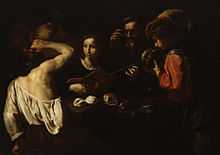Pietro Paolini
Pietro Paolini (3 June 1603 – 12 April 1681) was an Italian painter of the Baroque period. He is also called Paolino which is an affectionate diminutive of his lastname.
.jpg)
He was born in Lucca, the son of Tommaso Paolini and Ginevra Raffaelli. In 1619, Paolini‘s father sent him to study under Angelo Caroselli in Rome, where he stayed till about 1628-29, and was strongly influenced by the circle of Bartolomeo Manfredi and other Caravaggisti. From c. 1629-1631 he lived for two years in Venice. He returned to Lucca in 1631 when his father died, and established a studio where he created an original style, in which he painted still lifes and cabinet pictures, often on musical or allegorical themes, including a series on Music, Astronomy, Geometry, and Philosophy. In 1652 he opened, an academy based on principle of art from nature, at which numerous artists, such as Girolamo Scaglia, Antonio Franchi, Simone del Tintore and his brother Francesco (1645–1718) were trained.[1] Giovanni Coli and Filippo Gherardi were also pupils. He influenced Giovanni Domenico Lombardi (1682–1751).

It has been suggested that Pietro Paolino either was himself or was influenced by the elusive Caravaggist painter known as the Pensionero de Saraceni (or Pensioner (house-mate) of Carlo Saraceni). A room of his paintings can be found in the Museo Nazionale di Villa Guinigi in Lucca.[3] One other painting, Adoration of the shepherds, can be seen in the collections of Fondazione Cassa di Risparmio di Lucca[4] and the painting A wife with her little daughter at the Musée Fesch Ajaccio (France, Corsica)[5]
References
- ↑ Biography in Lucca website.
- ↑ "Allegory of the Five Senses". The Walters Art Museum.
- ↑ Museo di Villa Guinigi in Lucca.
- ↑ Fondazione Cassa di Risparmio of Lucca
- ↑
External links
- Web Gallery of Art biography.
- A Caravaggio Rediscovered, The Lute Player, an exhibition catalog from The Metropolitan Museum of Art (fully available online as PDF), which contains material on paolini (see cat. no 13-14)
| Wikimedia Commons has media related to Pietro Paolini. |
|